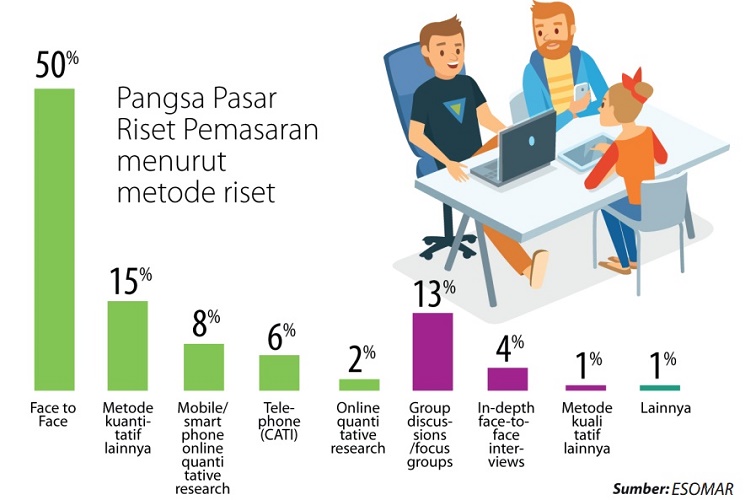Based on the annual report of ESOMAR Global Market Research 2016 , quantitative research still take the largest percentage of market marketing research in 2015, which amounted to 70%. While the rest is distributed among the qualitative research (16%) and other types of research (14%), which included desk research and new methods such as the analysis of big data . Online quantitative research into the main methodologies in quantitative research undertaken by market research agencies in the world (23%), while spending on research are greatest qualitative focus group discussions (FGD) (8%) .

market research
In Indonesia, the quantitative research (81%) and qualitative (18%) appears to be greater market share. Conversely, other research type only get a very small portion (1%). Many research done globally or regionally, and it seems the early stages of exploration based on secondary data has not been much done in Indonesia. In addition, research with new technology seemed not been widely used in Indonesian clients.
Further, the report notes that in Indonesia FGD also took the largest portion when compared with other qualitative research methods (13%). The unique situation in Indonesia is still the persistence of domination methods of data collection in face-to-face (50%), while the use of quantitative research online still have not received significant usage (2%).
In the global environment, the survey online has gained popularity because of its benefits are not small. Surveys online requires lower costs because the costs are usually allocated to the paper questionnaire, distribution, and delivery of data is no longer needed. Surveys online also minimize human error. Survey questions can be arranged so that the respondent will not miss the questions to be answered.
Not only that, the survey online also provides more comfort for the respondents. Respondents could provide the answer by following their personal schedules, and they can be more open in answering questions of a personal nature. Moreover, the main advantage of surveys online is a quick survey. This methodology is no longer a time consuming which is normally required for the distribution and delivery of paper questionnaires back often encounter obstacles. The data analysis also has become more efficient because of the availability of data more quickly: when respondents enter their answers in real-time data will be stored in the form of electronic data.
However, surveys online have weaknesses and problems of its own. Unlike research conducted face-to-face, online research is generally done using respondents who had enrolled in a panel. This can cause some problems because companies can only reach those who are online and are willing to become a member of the panel.
They are listed in the panel line also generally only come from a younger age group. A comparative study between the two methodologies that did reported that online research using a sample panel looks more attractive the more knowledgeable . On the other hand, survey respondents face-to-face has the social desirability of higher due to the presence of the interviewer time of the survey. Not only that, other studies have also found that the survey online to generate more response "do not know" when compared with face-to-face surveys.
Association of Indonesian Internet Network (APJII) reported that more than half of Indonesia's population is now connected to the internet. In Indonesia, the growth rate of Internet users by 2016 and has reached 132 million people. Since the Internet became an integral part of everyday life, it is not surprising that surveys online has become a trend for all global research firm. However, why is not the case in Indonesia?
market research
One of the challenges of the survey online in the country is uneven internet penetration in all regions of Indonesia. Based on data from APJII, 65% of the total Internet users in Indonesia comes from Java, while the rest are scattered in various parts of the archipelago; 15.7% in Sumatra, Sulawesi 6.3%, 5.8% in Kalimantan, 4.7% in Bali and NTB, and 2.5% in Maluku and Papua. This can pose a challenge in which the online sample can not represent the entire population of the country.
Moreover, the lack of local human resources quality is also a challenge for the implementation of the survey online in Indonesia. The public's understanding of the market research industry insufficient cause not many people voluntarily join a panel of online and participate in market research. In this regard, fraudulent behavior or cheating has also become one of the risks that need to be anticipated from the implementation of the survey online . Therefore, this type of survey does not involve the interviewer and / or QC in the process of recruitment of respondents, control over the quality of data provided respondents to be rather weak.
During recent years, new ways to understand consumers continue to be developed and introduced in the market research industry. One methodology that is currently on the rise is the analysis of big data . In addition, we have also seen the development of mobile research, facial-coding, eye-tracking , and much more as part of innovations in the market research methods. Of course, each methodology has its strengths and weaknesses of each. Question we need not catapult which one is better or worse, but the method is appropriate to the research objectives and specific situations.
Indonesia still prefer face to face surveys. However, technological progress will inevitably encourage innovation, development, and adaptation research methods in accordance with the market dynamics, which is able to capture the reality accurately, quickly, and cost-efficient.